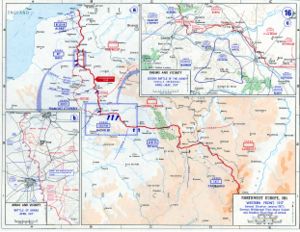Tactical development on the Western Front in 1917
| Western Front | |||||||
|---|---|---|---|---|---|---|---|
| Part of World War I | |||||||
 Map of the Western Front, 1917. |
|||||||
|
|||||||
| Belligerents | |||||||
|
|
|
||||||
| Commanders and leaders | |||||||
| Ferdinand Foch from early 1918 | Helmuth von Moltke the Younger → Erich von Falkenhayn → Paul von Hindenburg and Erich Ludendorff → Hindenburg and Wilhelm Groener | ||||||
| Casualties and losses | |||||||
| 7,947,000 | 5,603,000 | ||||||
![]() France and the French Overseas Empire
France and the French Overseas Empire
In 1917, during World War I, the armies on the Western Front continued to change their fighting methods, due to the consequences of increased firepower, more automatic weapons, decentralisation of authority and the integration of specialised branches, equipment and techniques into the traditional structures of infantry, artillery and cavalry. Tanks, railways, aircraft, lorries, chemicals, concrete and steel, photography, wireless and advances in medical science increased in importance in all of the armies, as did the influence of the material constraints of geography, climate, demography and economics. The armies encountered growing manpower shortages, caused by the need to replace the losses of 1916 and by the competing demands for labour by civilian industry and agriculture. Dwindling manpower was particularly marked in the French and German armies, which made considerable changes in their methods during the year, simultaneously to pursue military-strategic objectives and limit casualties.
The French returned to a strategy of decisive battle in the Nivelle Offensive in April, using methods pioneered at the Battle of Verdun in December 1916, to break through the German defences on the Western front and return to manoeuvre warfare (Bewegungskrieg) but ended the year recovering from the disastrous result. The German army attempted to avoid the high infantry losses of 1916 by withdrawing to new deeper and dispersed defences. Defence in depth was intended to nullify the growing material strength of the Allies, particularly in artillery and succeeded in slowing the growth of Anglo-French battlefield superiority. The British Expeditionary Force (BEF) continued its evolution into a mass army, capable of imposing itself on a continental power, took on much of the military burden borne by the French and Russian armies since 1914 and left the German army resorting to expedients to counter the development of its increasingly skilful use of fire-power and technology. During 1917 the BEF also encountered the manpower shortages affecting the French and Germans and at the Battle of Cambrai in December, experienced its biggest German attack since 1915, as German reinforcements began to flow from the Eastern Front.
...
Wikipedia
